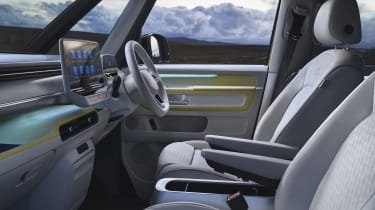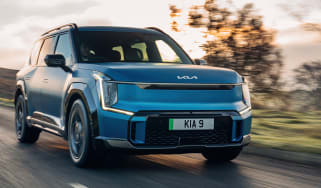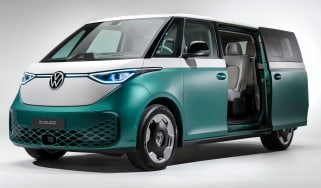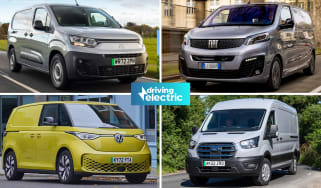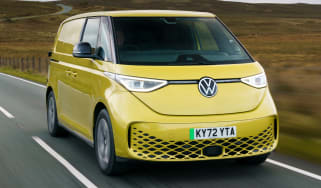Volkswagen ID. Buzz review
The ID. Buzz combines funky styling, a functional cabin and refinement to create a unique electric family car – and a particularly pricey one at that
Pros
- Funky styling
- Thoughtful features
- 170kW fast charging
Cons
- Frustrating infotainment system
- Seven seats not available yet
- Not cheap
| Car type | Range | Wallbox charge time | Rapid charge time |
|---|---|---|---|
| Electric | 255-258 miles | 12hrs 15mins (0-100%, 7.4kW) | 30mins (5-80%, 170kW) |
Volkswagen ID. Buzz verdict
Few cars are worthy of the hype surrounding them as much as the Volkswagen ID. Buzz is. It’s not quite as practical or versatile as some other van-based people-carriers, but it can go further on a charge, and charge faster than any of them, too. Plus, no electric SUV out there can match the space or family-friendly features of the supremely funky ID. Buzz.
Its styling might be what draws customers in, but beneath the Microbus-inspired looks, this is a very capable, if slightly pricey, EV. We wish the ID. Buzz was available with seven seats at launch, but it will be soon, and there’s a camper-van variant in the works as well.
Range details, specs and alternatives
The Volkswagen ID. Buzz was one of the hottest new car reveals of recent times, coupling styling inspiration from VW’s classic Type 2 Microbus with clean, all-electric power. The underpinnings are familiar; the ID. Buzz uses the 77kWh battery that’s offered in the Volkswagen ID.3, ID.4 and ID.5, with the same 201bhp electric motor mounted on the rear axle. Depending on which trim level you pick, the official range varies from 255 to 258 miles.
There are a couple of other electric minibuses on the market right now, namely the nine-seat Citroen e-SpaceTourer, Vauxhall Vivaro Life Electric and Peugeot e-Traveller, as well as the seven-seater Peugeot e-Rifter, Citroen e-Berlingo and Vauxhall Combo Life Electric. It'll also compete with the Ford E-Tourneo Custom arriving later this year. But, unlike all of its rivals, the ID. Buzz isn’t based on a commercial vehicle as such. There is a panel van version, called the ID. Buzz Cargo, but even that was created with an electric passenger car in mind from the outset.
It’s also a more premium-feeling product than its van-derived competition, so we expect many people will be considering the ID. Buzz in addition to some of the larger electric family cars out there, such as the Tesla Model Y, Skoda Enyaq iV, Nissan Ariya, BMW iX3 and Mercedes EQB. The ID. Buzz is only available as a five-seater for the moment, but you will be able to get it with seven seats soon, hopefully by the end of 2023.
The starting price of the ID. Buzz is higher than almost all its competition, though. Entry-level Life models start from over £57,000, which no matter how you slice it is a lot of money for a family-focused people carrier. At least you get a heated steering wheel, reversing camera, keyless start, adaptive cruise control and 19-inch alloy wheels, plus 40:60 split-folding rear bench, sliding rear doors and a 5.3-inch digital driver’s display. There’s a 10-inch touchscreen, too, with Apple CarPlay and Android Auto connectivity.
Meanwhile, the ID. Buzz Style is priced at close to £62,000 and comes with 20-inch alloys, ambient lighting, stainless steel 'Play' and 'Pause' pedals, a powered tailgate, matrix LED headlights and two-tone cloth upholstery. If you manage to get your hands on the now sold out 1st Edition Buzz you’re rewarded with a larger 12-inch touchscreen, 21-inch alloys and upgraded seats for the driver and front passenger, plus some other goodies. Buyers also get a choice of two-tone paint schemes (a pricey £1,800 option) which incorporate a white U-shaped bonnet and roof; another nod to the iconic Type 2 Microbus from the 50s and 60s.

For a more detailed look at the Volkswagen ID. Buzz, read on for the rest of our in-depth review..

